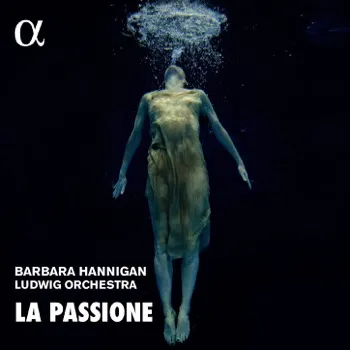Barbara Hannigan describes her new release, “La Passione”, as a “triptych of three transfigured nights.” Each of the works featured on this album – by Nono, Haydn, and Grisey – takes the listener through part of a powerful emotional journey of suffering, passion, and death.

Luigi Nono’s “Djamila Boupacha” is a gripping start to the album. Boupacha, an Algerian militant arrested by the French Army, was subsequently tortured to extract a confession for her actions. The cruel nature of the punishment became a subject of politics, literature, and art. Nono does not present a discernible melodic line in his work, making the listener come to terms with its disjointed unrest and a consequent emotional turmoil. Hannigan’s performance is moving and one of dichotomies: it is beckoning and distant yet terrifying and aggressive; introspective yet impassioned. Her voice control here is remarkable. Even within the first few seconds, we already feel a tension building. Although we anticipate that something is about to happen, that leaves us no better prepared for when she expresses Boupacha’s visceral pain.
On paper, the Nono track seems at stylistic odds with a Haydn symphony. This progression, however, makes paradoxical sense as a second part of the listener’s journey. Where Djamila Boupacha leaves us in emotional disarray, Haydn’s Symphony No.49 (“La Passione”) is an equally cathartic response, fitting especially as it was written at the height of the composer’s Sturm und Drang period, something that Hannigan mentions as a stylistic commonality between the two works.
The Symphony’s first movement is a complex tapestry that speaks to two sides of tragedy: large-scale phrases express its extroverted drama while the shorter two-note phrases speak to its delicate nature. The only drawback to this beautiful performance is that the orchestra-harpsichord balance is too lopsided. Hannigan notes that the addition of the harpsichord was meant as a symbolic struggle to express its own voice. While this is true, it’s a shame that this struggle is relegated to more of an odd afterthought, overpowered by the orchestra. As far as versions go, a notable comparison is Giovanni Antonini’s, who delivers this Symphony on Volume 1 of his Haydn 2032 series. The harpsichord does not feature in the movement and, as opposed to the current release, period instruments are used: while they are not as resonant as their modern counterparts, what they do present is a more intimate and elegant interpretation of the work, whereas the Hannigan recording carries a pathos that quickly envelops the listener.
The second movement is a real highlight in its sheer excitement. We hear the raw intensity of the instrumentalists, down to the scratching of their bows. The low strings are solid, delivering both power and precision that lends a perpetual drive to the movement. Another component of this drive is the contrast between aspects of the orchestra’s playing: the longer phrases, despite being sonorous, are nicely contoured. The accents, on the other hand, are angular and jolting. Though they border on being uncontrolled at times, this creates the edge this movement needs. The third movement has both a dance-like quality and measured stateliness through the string section’s excellent bow control. In the short trio section, however, I did wish for a more pronounced contribution by the horns, which can add a brightness to the orchestral texture that fits the section’s character, but here sound too subdued.
Gerald Grisey’s “Quatre chants pour franchir le seuil” is the final leg in the journey, evoking a haunting introspectiveness and finality in its ruminations upon death (as it happens, this piece was Grisey’s final completed work before his own untimely death). It is interesting to note the unifying feature between the opening Nono piece to the first four Grisey songs, which open with only percussion, creating a whispering eeriness and a tension in some ways akin to the beginning of the Nono. Though the entire cycle is wonderful, two tracks stand out. “Les heures à la nuit: (track 6), based upon a poem by Grisey’s contemporary Christian Guez-Ricord, describes the death of an angel. The performance is poignant: the meandering, minimalistic nature of the instrumental accompaniment thrusts Hannigan into the forefront with a passionate voice of urgent pain. It vividly reflects Grisey’s own words about the piece: that the death of an angel is one of the worst types of death, as it forces us to mourn our own dreams.
“La mort de la voix” (track 8) takes its inspiration from the words of Ancient Greek poet Erinna. Describing the underworld, it features strings and woodwinds used in unconventional registers and melodic patterns to give them highly uncharacteristic sounds. This effective performance throws us into an unfamiliar and cacophonous world. Despite the initial confusion, clarity begins to emerge when we realize the title’s musical symbolism: it is as though these instruments have experienced the death of their instrumental voice. It’s quite fascinating to hear how, as this track progresses, Hannigan’s voice melts into the instruments’ lines until it becomes indistinguishable.
The liner notes give Hannigan’s sincere and insightful perspective on the works she chose for this album, as well as translated texts of the vocal works. The rest, however, is left up to listeners to experience for themselves through a powerful and very well-conceived recording.
Top image: Marco Borggreve
“La Passione“
Nono – “Djamila Boupacha” for Soprano Solo
Haydn – Symphony No.49 (“La Passione”)
Grisey – Quatre Chants Pour Franchir Le Seuil for Soprano & Ensemble
Barbara Hannigan – Soprano and Conductor
Ludwig Orchestra
Alpha Classics, CD ALPHA 586




















